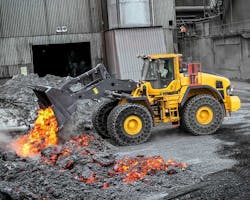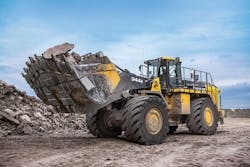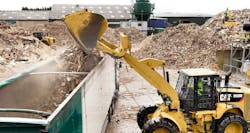The Most Fill for the Bucket
Construction buckets, whether they be on excavators, loaders, backhoes, or innumerable other material movers, are the real power brokers on a construction site. A piece of heavy equipment powered by unlimited horsepower, with future-forward technologies, and controlled by a superstar operator can’t even clock in until the bucket shows up on site.
Bucket experts say productive buckets result from pre-design conversations, its fabrication material, and the balancing of geometry to the materials it will move.
Jason Simmons, attachments engineering supervisor at John Deere, says designing a great bucket starts with listening to the customer to develop a deeper understanding of what they want and an appreciation of the capabilities of the host machine.
“The customer should develop some baseline data on their operation and expectations for a particular job,” Simmons says. “This starts with knowing the type of material and density being moved. Additionally, having information on what the bucket is loading into will help to size the bucket to the machine and operation appropriately.
“The attachments engineering department at Deere is responsible for taking this information to developing bucket solutions that manage both of these,” says Simmons. “A great bucket is one that can do one or more jobs for the customer, yet meets or exceed the customer’s productivity and durability expectations.”
Simmons gives this example: Deere heard from many landscape contractors who use their compact track loaders for not only material loading and unloading, but also did leveling and land-shaping jobs with the same unit. Armed with this information, Deere designed a grading heel bucket with a serrated edge that combines the loading and unloading capabilities of a traditional bucket with a squared-off heel for back dragging during final grading, allowing the customer to be more productive.
“In the end, having information before a bucket design is even started helps ensure that the bucket is designed and tested for the proper machine model,” Simmons says.
Pairing the bucket to the material itself—not just the amount of material—is a big factor in time and cost efficiency.
Mike Greco, product application specialist with Caterpillar, says, “Bucket capacity is based on the host machine’s digging performance and stability with regard to material density and characteristics. An example of this would be working with crushed stone at 2,600 pounds per cubic yard compared to moving municipal waste that weighs in at 1,000 to 1,800 pounds per cubic yard.”
To address this example, Cat designed a bucket that it says provides the perfect ratio of bucket floor length to the bucket’s throat opening angle, one of the company’s Performances Series buckets.
“As the machine operator penetrates the pile of crushed stone, material flows freely into the bucket cavity,” Greco says. “When the operator racks back, the bucket floor ‘throws’ the material aft, filling the bucket. Power is not wasted ‘dozing’ the material into the bucket.”
Cat tested a Performances Series bucket to load an on-road haul truck with quarry gravel and found that a properly designed bucket such as the one described above shaved two seconds off the digging time for each cycle. Greco says Cat figured those two seconds equaled 16 gallons of saved fuel per year and allowed the operator to load an additional two full buckets into each truck. Less directly, the test suggested that using the right bucket saved tire wear and minimized operator fatigue.
Equipment manufacturers make strong arguments for using their brand buckets with their host machines. The user gains optimum power ratios matching OEM buckets designed to the capabilities of the OEM’s equipment, as well as smoother and highly efficient operations. Importantly, matched units ensure machine stability that benefits the economies of the job such as load cycles, component wear, and safety, they say.
Simmons says a mismatched configuration works against the smooth operation of the machine, can result in less productivity and higher fuel usage, and in extreme circumstances, reduce the longevity of the machine.
Yet for users with several brands in their fleet, well-made aftermarket or specialty buckets are important options. The key is to match high-quality buckets with equally high-quality machines.
Lee Horton, president of Leading Edge Attachments, advises against the false economy of purchasing lesser-quality buckets that may be made of lower-grade steel or configured using layers of inexpensive steel to give the appearance of heft and durability. Layers of poor-grade steel will not improve the basic strength of the plates but will add unnecessary weight and corrosion points, both of which will result in higher operating and maintenance costs.
Horton prefers buckets made of Swedish AR-400 steel, sometimes referred to by its brand name Hardox 400. AR-400 is abrasion resistant, made of tempered alloy steels. The addition of carbon and manganese, coupled with quenching and tempering, increases the hardness of the steel and creates a durable, impact-resistant surface.
Look for streamlined profiles that will allow faster loading and improve material retention. Curved side plates and integrated spill guards are design features that increase productivity.
Horton also suggests verification of welds and plate thickness. On good-quality buckets, the weld seams are included in the fabrication specifications; they are that important to the performance and service life of the unit. Plate thickness should meet specs, remembering that, for example, two ½-inch plates do not equal a single 1-inch plate.
Verify the hardness of the plate material. Hardened metal is going to cost more at the front end but will pay for itself because it will resist scratching, abrasion, and indentations, resulting in a long work life. AR-400 is known for its superior strength. (The numbers after AR refer to the Brinell Hardness of the steel. Brinell testing is often used for very high test loads.) Ask for documentation of the unit’s hardness because it is difficult to identify the AR factor, especially if the bucket is oily or painted.
Give attention to the bucket’s wearable parts such as side cutters, edges, and teeth. Will these components be easy to reinstall and maintain? Are they made from metal that allows them to be refurbished? Bucket teeth are manufactured either by casting or forging. Casted teeth are frequently made of low-alloy steel with nickel and molybdenum added to improve strength and resist corrosion. Forged teeth are often made of a heat-treated alloy steel that lends itself to greater impact strength and improved wear properties.
Manufacturers are using technology to improve bucket design. Deere’s use of analytical tools and high-strength steels in the development of bucket designs is showing significant opportunities.
“Analytical tools are being used to show how the machine and bucket will perform before a bucket is ever built,” says Simmons. “This allows our design teams to cycle through numerous design concepts quickly and cost-effectively, and be closer to the end solution when field testing is started. That will lead to the most efficient bucket for machine operations in the shortest development time.
“Additionally, the use of high-strength steels in bucket construction is enabling more productive attachments,” he says. “High-strength steel creates weight savings while maintaining or exceeding the current durability performance of the product, leading to improvements to machine productivity through faster machine cycle times and higher amounts of material moved.”
Mark Mohn, Volvo’s director of attachments for region Americas, is seeing opportunities for buckets shaped specifically for select materials on specific job sites. Volvo recently added three new aggregate buckets—a sand bucket, a rehandling flat-floor bucket, and a rehandling bucket—that all fit its L110 to L350 wheel loaders.
“These intelligently designed buckets match not only the material being moved, but also the site where the material is located,” Mohn says. “The new sand rehandlers take into account things such as the balanced floor-back ratio to maximize traction and penetration, spill guards to deflect materials and protect the host machine’s linkage, convex side plates to better retain the material, and minimized pockets to prevent materials grades from mixing. The buckets are also optimized to be matched to a variety of ground conditions so that operators have an easier time capturing and delivering material.”
Mohn is also seeing opportunities for buckets designed for extreme applications that won’t fail under almost indescribable conditions. Volvo’s hot-slag handler bucket, found working at Harsco Metals in Norway, was originally a specialty bucket for Volvo’s Jern & Maskin AS dealer, built to haul cubic yards of 2,372 F molten liquid slag that is a by-product of the company’s scrap metal melting operation. Fitted to specially modified Volvo L220 wheel loaders, the hot-slag buckets carry the lava-like material to lay it out to cool before it is rehandled. Ronald Utland, site manager of Harsco Metals Norway, says, “Finding steel that doesn’t change structure when heated to more than 1,292 F is difficult, but essential in our business.” Volvo now offers a new range of buckets using more high-tensile steel that improves the durability as compared to other buckets by up to three times.
Caterpillar is strengthening its software by integrating scales into their production-management system on its medium wheel loader bucket arrangement. The loader’s system provides precise data on the weight of each bucket so there is no overloading or unloading of the trucks. Knowing the typical and/or most common size highway trucks the loader is filling, as well as the material’s density, allows the operator to determine the exact number of passes necessary. Not only does this mean fewer partial bucket passes, it also means trucks are loaded accurately the first time, eliminating reweighs or dumping before heading to the job site.


